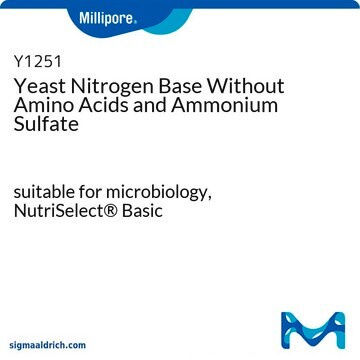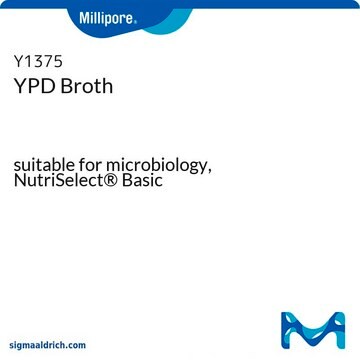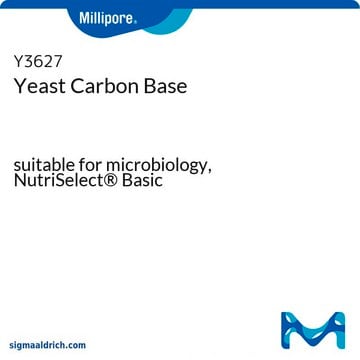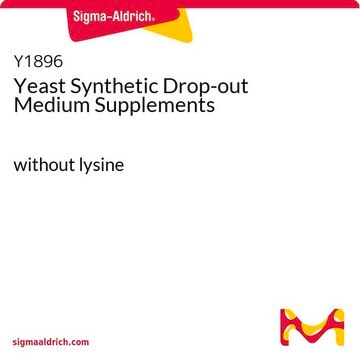Y0626
Yeast Nitrogen Base Without Amino Acids
Yeast classification medium used for selecting yeasts based on amino acid and carbohydrate requirements
Synonym(s):
ynb without amino acids
About This Item
Recommended Products
grade
for molecular biology
Quality Level
sterility
non-sterile
form
powder
technique(s)
microbe id | utilization test: suitable
microbiological culture: suitable
pH
5.2-5.6(0.67% solution)
application(s)
food and beverages
microbiology
storage temp.
room temp
suitability
nonselective for Candida spp.
nonselective for Pichia spp.
nonselective for Saccharomyces spp.
nonselective for Zygosaccharomyces spp.
yeasts
General description
Application
- in synthetic complete supplement mixture (SC)-Leu media used for Y. lipolytica culturing and characterization
- as a component of selective liquid media for uracil auxothrophic growth in yeast
- to evaluate the transformation efficiencies of S. cerevisiae strains, under different nutrient conditions
Components
Nitrogen Sources:
Ammonium sulfate, 5.0 g/L
Vitamins:
Biotin, 2.0
Calcium pantothenate, 400
Folic acid, 2.0
Inositol, 2.0 mg/L
Nicotinic acid, 400
p-Aminobenzoic acid, 200
Pyridoxine HCl, 400
Riboflavin, 200
Thiamine HCL, 400
Trace Elements:
Boric acid, 500
Copper sulfate, 40
Potassium iodide, 100
Ferric chloride, 200
Manganese sulfate, 400
Sodium molybdate, 200
Zinc sulfate, 400
Salts:
Potassium phosphate monobasic, 1.0 g/L
Magnesium sulfate, 0.5 g/L
Sodium chloride, 0.1 g/L
Calcium chloride, 0.1 g/L
Preparation Note
2. Warm if necessary to solubilize and sterilize by filtration.
Store 10× stock solution at 2-8 °C. To use, dilute 1:10 with sterile distilled water under aspetic conditions.
related product
Storage Class Code
13 - Non Combustible Solids
WGK
WGK 1
Flash Point(F)
Not applicable
Flash Point(C)
Not applicable
Personal Protective Equipment
Regulatory Listings
Regulatory Listings are mainly provided for chemical products. Only limited information can be provided here for non-chemical products. No entry means none of the components are listed. It is the user’s obligation to ensure the safe and legal use of the product.
ISHL Indicated Name
Substances Subject to be Indicated Names
ISHL Notified Names
Substances Subject to be Notified Names
JAN Code
Y0626-1KG:4548173215365
Y0626-1KG-PW:
Y0626-BULK:
Y0626-VAR:
Y0626-1KG-C:
Y0626-250G-PW:
Y0626-250G-C:
Y0626-250G:4548173215372
Certificates of Analysis (COA)
Search for Certificates of Analysis (COA) by entering the products Lot/Batch Number. Lot and Batch Numbers can be found on a product’s label following the words ‘Lot’ or ‘Batch’.
Already Own This Product?
Find documentation for the products that you have recently purchased in the Document Library.
Customers Also Viewed
Articles
SeqPlex™-I WTA kit amplifies RNA for NGS, enabling genomic studies from limited samples.
Traditional methods are based morphology, staining methods, enzyme reactions (metabolism) and diverse media.
Protocols
Magnetic-plasmonic nanoparticles: Synthesis and application of Ag/FeCo/Ag nanobeads for cellular organelle imaging and isolation.
Yeast culture techniques: Model systems for eukaryotic studies with liquid media or agar plate growth.
Related Content
KOD One™ PCR Master Mix overview for ultra-fast PCR with high specificity, fidelity, and yield
Our team of scientists has experience in all areas of research including Life Science, Material Science, Chemical Synthesis, Chromatography, Analytical and many others.
Contact Technical Service














